Early Social Development docx.
VerifiedAdded on 2022/08/13
|8
|2346
|11
AI Summary
Contribute Materials
Your contribution can guide someone’s learning journey. Share your
documents today.
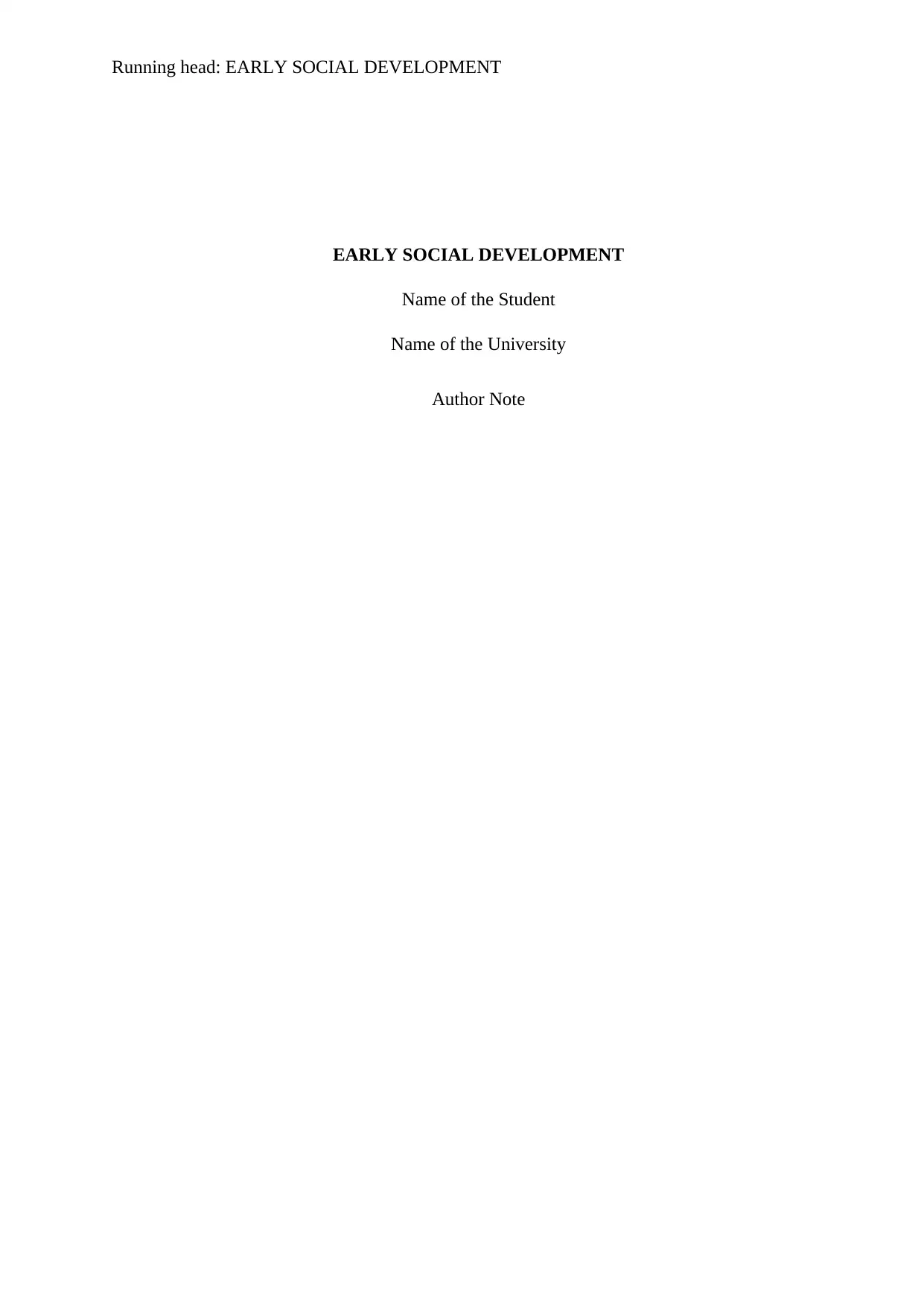
Running head: EARLY SOCIAL DEVELOPMENT
EARLY SOCIAL DEVELOPMENT
Name of the Student
Name of the University
Author Note
EARLY SOCIAL DEVELOPMENT
Name of the Student
Name of the University
Author Note
Secure Best Marks with AI Grader
Need help grading? Try our AI Grader for instant feedback on your assignments.

1
EARLY SOCIAL DEVELOPMENT
A lot of social as well as emotional development takes place in early childhood.
Various factors affect the social development of the child such as- environment at home,
economic status, community, programmes in school as well as the love and affection that
they get from their parents. To ensure that the child has acquired correct skills and behaviour,
the parents must take care of the above factors. Psychology was received slowly by people
because it was comparatively complex. It has been subjected to philosophical as well as
theoretical controversies. Motivation, as well as emotion, are the most complex concept of
psychology (Eysenck 2013). The main characteristics of early social development include
cooperation, sharing, participation as well as discipline. Ensuring the active development of
the child is an essential criterion. The essay aims to explain the evolution of attachment
concerning nature-nurture along with some theories to support the writing.
Many psychological viewpoints have been discussed by the many theorists regarding
the social development of the child. The psychology of a child depends on various factors
such as as-perceptions, psychological development, motivation, intelligence, learning,
emotion and others (Nolen et al 2014). The five essential theories or viewpoints include
Erikson’s theory of psychosocial development, Bowlby’s theory of attachment, Freud’s
theory of psychosexual development and the cognitive development theory propagated by
Piaget. Erikson’s theory gave an outline for organizing the growth in humans throughout all
eight stages of life. According to him, an essential part of a child is social interaction as well
as experience (Syed and McLean 2017). Freud’s psychosexual theory of development
explained the skills of a child at different stages in childhood that dictate the behaviour as
well as personality patterns in adulthood. The cognitive development theory propagated by
Piaget divided the child life into four phases and every stage had its vulnerabilities and
qualities. The child development theories help the adults to understand the process of human
development. The child development now is not just limited to early development but has
EARLY SOCIAL DEVELOPMENT
A lot of social as well as emotional development takes place in early childhood.
Various factors affect the social development of the child such as- environment at home,
economic status, community, programmes in school as well as the love and affection that
they get from their parents. To ensure that the child has acquired correct skills and behaviour,
the parents must take care of the above factors. Psychology was received slowly by people
because it was comparatively complex. It has been subjected to philosophical as well as
theoretical controversies. Motivation, as well as emotion, are the most complex concept of
psychology (Eysenck 2013). The main characteristics of early social development include
cooperation, sharing, participation as well as discipline. Ensuring the active development of
the child is an essential criterion. The essay aims to explain the evolution of attachment
concerning nature-nurture along with some theories to support the writing.
Many psychological viewpoints have been discussed by the many theorists regarding
the social development of the child. The psychology of a child depends on various factors
such as as-perceptions, psychological development, motivation, intelligence, learning,
emotion and others (Nolen et al 2014). The five essential theories or viewpoints include
Erikson’s theory of psychosocial development, Bowlby’s theory of attachment, Freud’s
theory of psychosexual development and the cognitive development theory propagated by
Piaget. Erikson’s theory gave an outline for organizing the growth in humans throughout all
eight stages of life. According to him, an essential part of a child is social interaction as well
as experience (Syed and McLean 2017). Freud’s psychosexual theory of development
explained the skills of a child at different stages in childhood that dictate the behaviour as
well as personality patterns in adulthood. The cognitive development theory propagated by
Piaget divided the child life into four phases and every stage had its vulnerabilities and
qualities. The child development theories help the adults to understand the process of human
development. The child development now is not just limited to early development but has
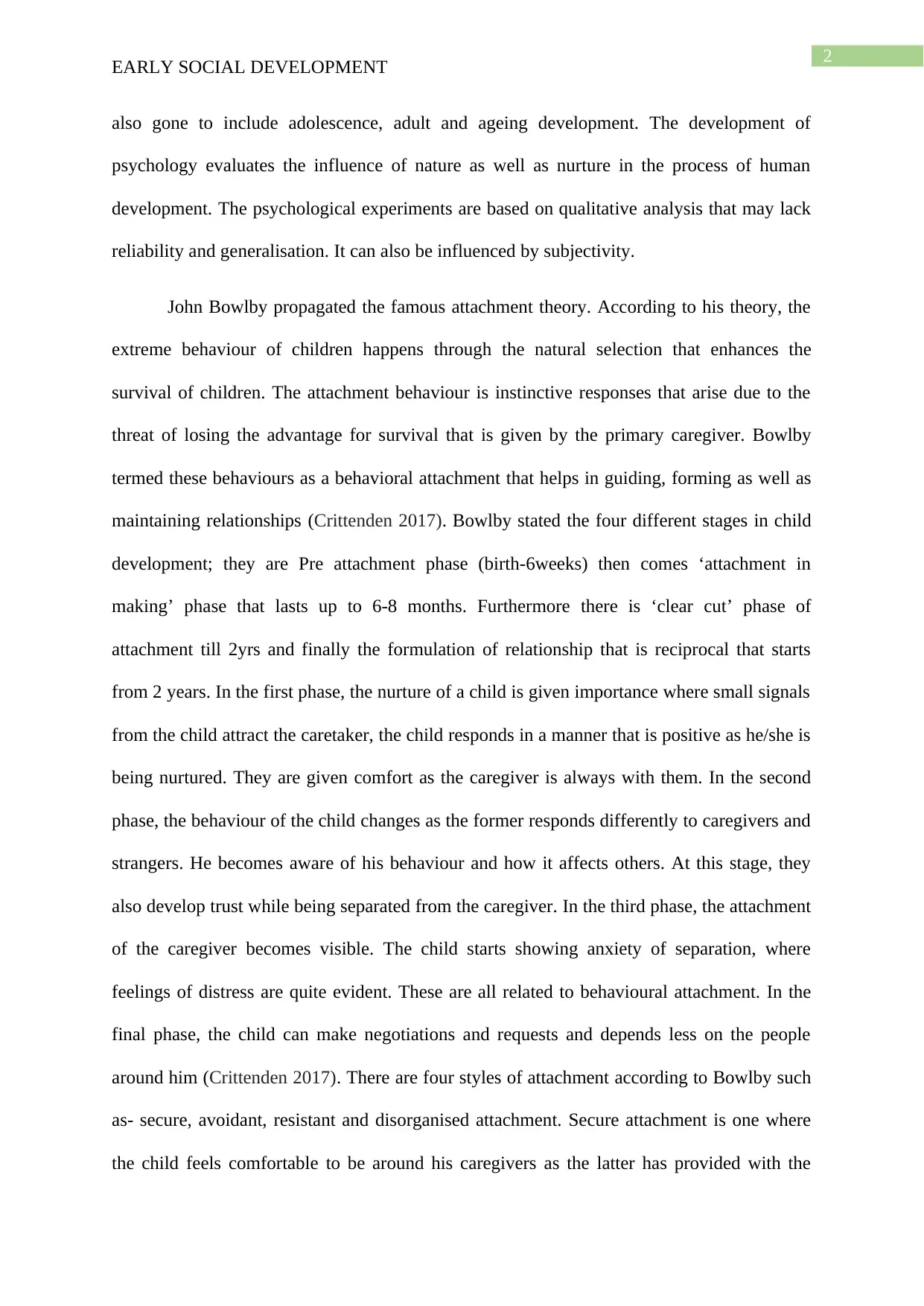
2
EARLY SOCIAL DEVELOPMENT
also gone to include adolescence, adult and ageing development. The development of
psychology evaluates the influence of nature as well as nurture in the process of human
development. The psychological experiments are based on qualitative analysis that may lack
reliability and generalisation. It can also be influenced by subjectivity.
John Bowlby propagated the famous attachment theory. According to his theory, the
extreme behaviour of children happens through the natural selection that enhances the
survival of children. The attachment behaviour is instinctive responses that arise due to the
threat of losing the advantage for survival that is given by the primary caregiver. Bowlby
termed these behaviours as a behavioral attachment that helps in guiding, forming as well as
maintaining relationships (Crittenden 2017). Bowlby stated the four different stages in child
development; they are Pre attachment phase (birth-6weeks) then comes ‘attachment in
making’ phase that lasts up to 6-8 months. Furthermore there is ‘clear cut’ phase of
attachment till 2yrs and finally the formulation of relationship that is reciprocal that starts
from 2 years. In the first phase, the nurture of a child is given importance where small signals
from the child attract the caretaker, the child responds in a manner that is positive as he/she is
being nurtured. They are given comfort as the caregiver is always with them. In the second
phase, the behaviour of the child changes as the former responds differently to caregivers and
strangers. He becomes aware of his behaviour and how it affects others. At this stage, they
also develop trust while being separated from the caregiver. In the third phase, the attachment
of the caregiver becomes visible. The child starts showing anxiety of separation, where
feelings of distress are quite evident. These are all related to behavioural attachment. In the
final phase, the child can make negotiations and requests and depends less on the people
around him (Crittenden 2017). There are four styles of attachment according to Bowlby such
as- secure, avoidant, resistant and disorganised attachment. Secure attachment is one where
the child feels comfortable to be around his caregivers as the latter has provided with the
EARLY SOCIAL DEVELOPMENT
also gone to include adolescence, adult and ageing development. The development of
psychology evaluates the influence of nature as well as nurture in the process of human
development. The psychological experiments are based on qualitative analysis that may lack
reliability and generalisation. It can also be influenced by subjectivity.
John Bowlby propagated the famous attachment theory. According to his theory, the
extreme behaviour of children happens through the natural selection that enhances the
survival of children. The attachment behaviour is instinctive responses that arise due to the
threat of losing the advantage for survival that is given by the primary caregiver. Bowlby
termed these behaviours as a behavioral attachment that helps in guiding, forming as well as
maintaining relationships (Crittenden 2017). Bowlby stated the four different stages in child
development; they are Pre attachment phase (birth-6weeks) then comes ‘attachment in
making’ phase that lasts up to 6-8 months. Furthermore there is ‘clear cut’ phase of
attachment till 2yrs and finally the formulation of relationship that is reciprocal that starts
from 2 years. In the first phase, the nurture of a child is given importance where small signals
from the child attract the caretaker, the child responds in a manner that is positive as he/she is
being nurtured. They are given comfort as the caregiver is always with them. In the second
phase, the behaviour of the child changes as the former responds differently to caregivers and
strangers. He becomes aware of his behaviour and how it affects others. At this stage, they
also develop trust while being separated from the caregiver. In the third phase, the attachment
of the caregiver becomes visible. The child starts showing anxiety of separation, where
feelings of distress are quite evident. These are all related to behavioural attachment. In the
final phase, the child can make negotiations and requests and depends less on the people
around him (Crittenden 2017). There are four styles of attachment according to Bowlby such
as- secure, avoidant, resistant and disorganised attachment. Secure attachment is one where
the child feels comfortable to be around his caregivers as the latter has provided with the
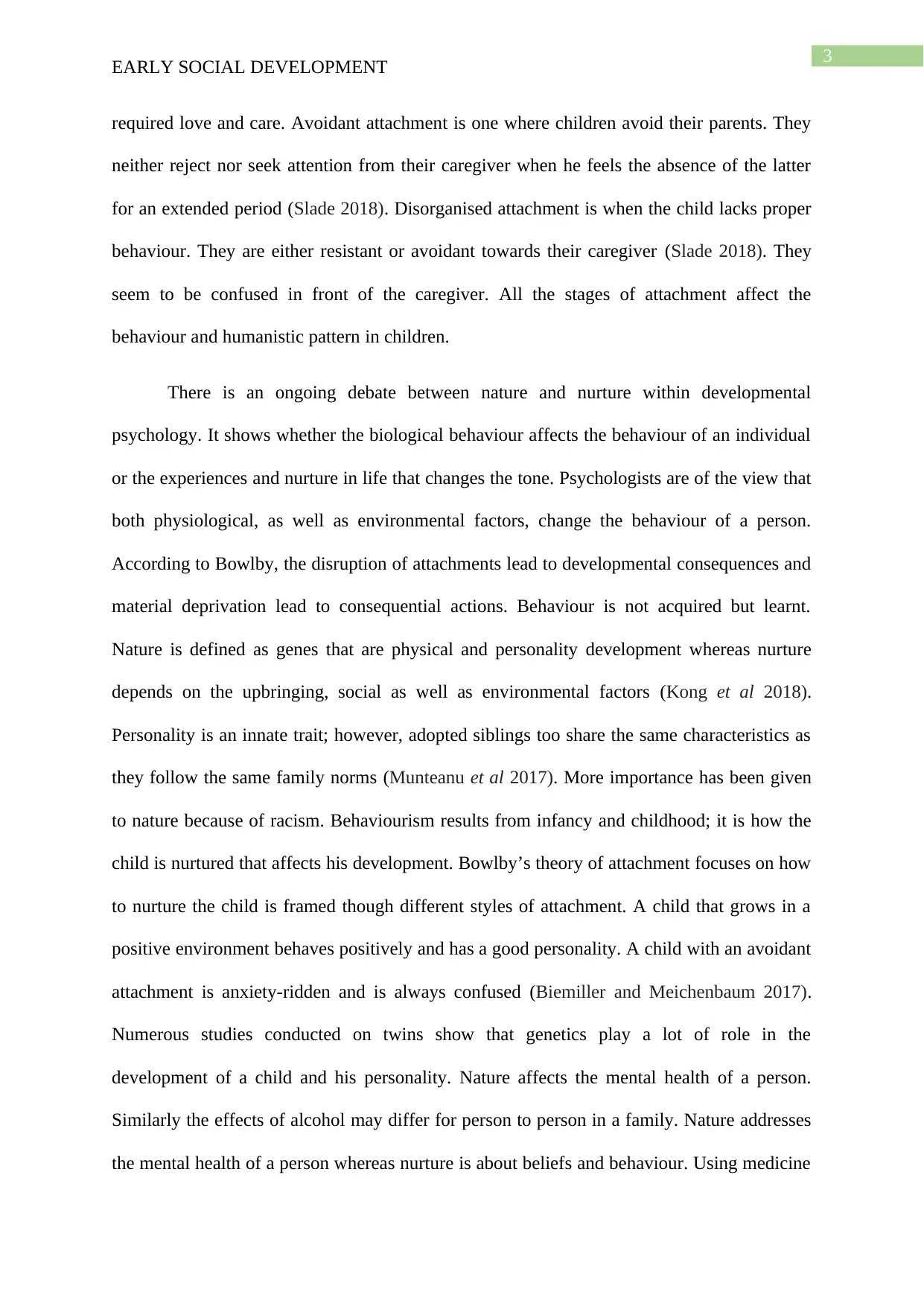
3
EARLY SOCIAL DEVELOPMENT
required love and care. Avoidant attachment is one where children avoid their parents. They
neither reject nor seek attention from their caregiver when he feels the absence of the latter
for an extended period (Slade 2018). Disorganised attachment is when the child lacks proper
behaviour. They are either resistant or avoidant towards their caregiver (Slade 2018). They
seem to be confused in front of the caregiver. All the stages of attachment affect the
behaviour and humanistic pattern in children.
There is an ongoing debate between nature and nurture within developmental
psychology. It shows whether the biological behaviour affects the behaviour of an individual
or the experiences and nurture in life that changes the tone. Psychologists are of the view that
both physiological, as well as environmental factors, change the behaviour of a person.
According to Bowlby, the disruption of attachments lead to developmental consequences and
material deprivation lead to consequential actions. Behaviour is not acquired but learnt.
Nature is defined as genes that are physical and personality development whereas nurture
depends on the upbringing, social as well as environmental factors (Kong et al 2018).
Personality is an innate trait; however, adopted siblings too share the same characteristics as
they follow the same family norms (Munteanu et al 2017). More importance has been given
to nature because of racism. Behaviourism results from infancy and childhood; it is how the
child is nurtured that affects his development. Bowlby’s theory of attachment focuses on how
to nurture the child is framed though different styles of attachment. A child that grows in a
positive environment behaves positively and has a good personality. A child with an avoidant
attachment is anxiety-ridden and is always confused (Biemiller and Meichenbaum 2017).
Numerous studies conducted on twins show that genetics play a lot of role in the
development of a child and his personality. Nature affects the mental health of a person.
Similarly the effects of alcohol may differ for person to person in a family. Nature addresses
the mental health of a person whereas nurture is about beliefs and behaviour. Using medicine
EARLY SOCIAL DEVELOPMENT
required love and care. Avoidant attachment is one where children avoid their parents. They
neither reject nor seek attention from their caregiver when he feels the absence of the latter
for an extended period (Slade 2018). Disorganised attachment is when the child lacks proper
behaviour. They are either resistant or avoidant towards their caregiver (Slade 2018). They
seem to be confused in front of the caregiver. All the stages of attachment affect the
behaviour and humanistic pattern in children.
There is an ongoing debate between nature and nurture within developmental
psychology. It shows whether the biological behaviour affects the behaviour of an individual
or the experiences and nurture in life that changes the tone. Psychologists are of the view that
both physiological, as well as environmental factors, change the behaviour of a person.
According to Bowlby, the disruption of attachments lead to developmental consequences and
material deprivation lead to consequential actions. Behaviour is not acquired but learnt.
Nature is defined as genes that are physical and personality development whereas nurture
depends on the upbringing, social as well as environmental factors (Kong et al 2018).
Personality is an innate trait; however, adopted siblings too share the same characteristics as
they follow the same family norms (Munteanu et al 2017). More importance has been given
to nature because of racism. Behaviourism results from infancy and childhood; it is how the
child is nurtured that affects his development. Bowlby’s theory of attachment focuses on how
to nurture the child is framed though different styles of attachment. A child that grows in a
positive environment behaves positively and has a good personality. A child with an avoidant
attachment is anxiety-ridden and is always confused (Biemiller and Meichenbaum 2017).
Numerous studies conducted on twins show that genetics play a lot of role in the
development of a child and his personality. Nature affects the mental health of a person.
Similarly the effects of alcohol may differ for person to person in a family. Nature addresses
the mental health of a person whereas nurture is about beliefs and behaviour. Using medicine
Secure Best Marks with AI Grader
Need help grading? Try our AI Grader for instant feedback on your assignments.
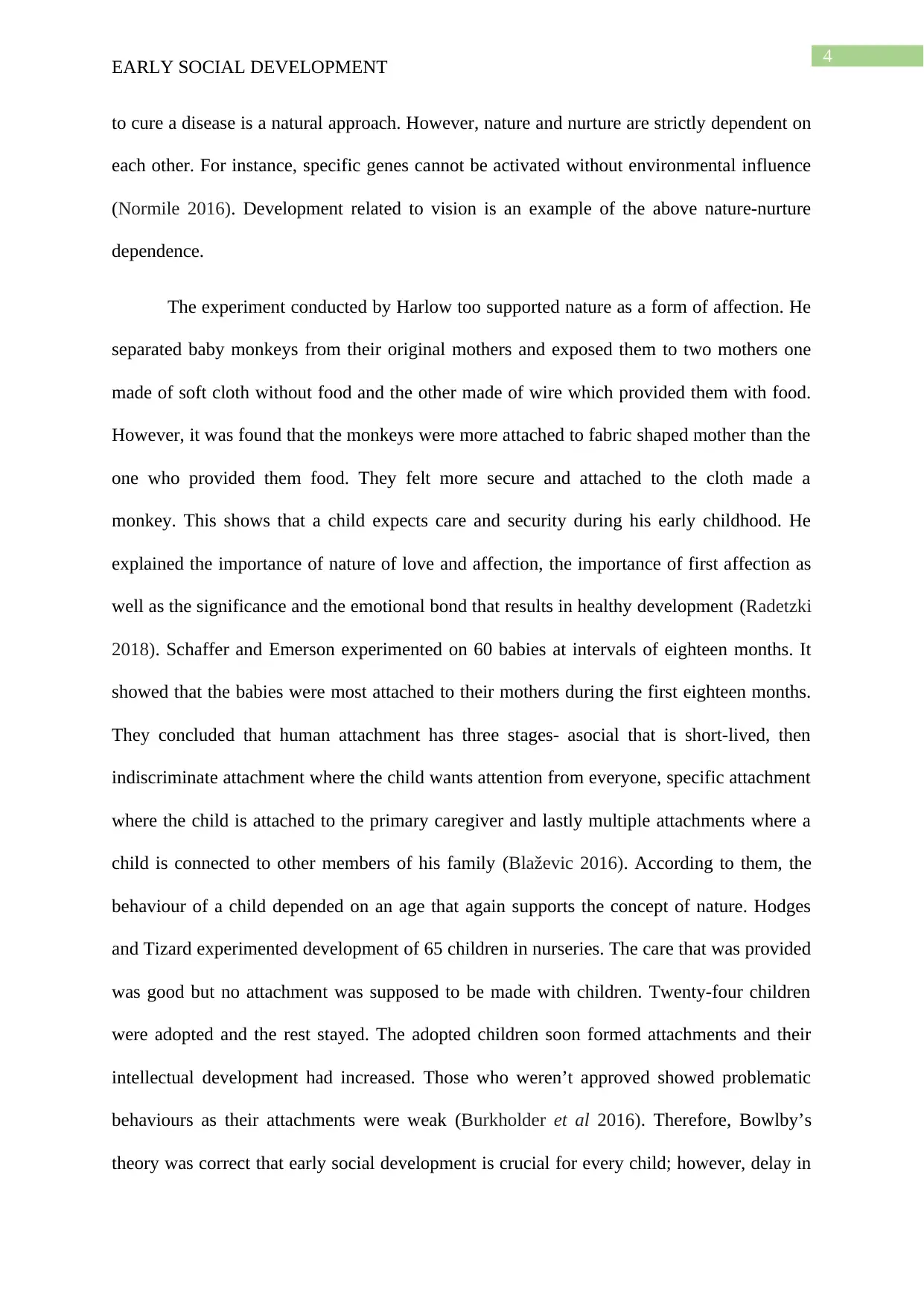
4
EARLY SOCIAL DEVELOPMENT
to cure a disease is a natural approach. However, nature and nurture are strictly dependent on
each other. For instance, specific genes cannot be activated without environmental influence
(Normile 2016). Development related to vision is an example of the above nature-nurture
dependence.
The experiment conducted by Harlow too supported nature as a form of affection. He
separated baby monkeys from their original mothers and exposed them to two mothers one
made of soft cloth without food and the other made of wire which provided them with food.
However, it was found that the monkeys were more attached to fabric shaped mother than the
one who provided them food. They felt more secure and attached to the cloth made a
monkey. This shows that a child expects care and security during his early childhood. He
explained the importance of nature of love and affection, the importance of first affection as
well as the significance and the emotional bond that results in healthy development (Radetzki
2018). Schaffer and Emerson experimented on 60 babies at intervals of eighteen months. It
showed that the babies were most attached to their mothers during the first eighteen months.
They concluded that human attachment has three stages- asocial that is short-lived, then
indiscriminate attachment where the child wants attention from everyone, specific attachment
where the child is attached to the primary caregiver and lastly multiple attachments where a
child is connected to other members of his family (Blaževic 2016). According to them, the
behaviour of a child depended on an age that again supports the concept of nature. Hodges
and Tizard experimented development of 65 children in nurseries. The care that was provided
was good but no attachment was supposed to be made with children. Twenty-four children
were adopted and the rest stayed. The adopted children soon formed attachments and their
intellectual development had increased. Those who weren’t approved showed problematic
behaviours as their attachments were weak (Burkholder et al 2016). Therefore, Bowlby’s
theory was correct that early social development is crucial for every child; however, delay in
EARLY SOCIAL DEVELOPMENT
to cure a disease is a natural approach. However, nature and nurture are strictly dependent on
each other. For instance, specific genes cannot be activated without environmental influence
(Normile 2016). Development related to vision is an example of the above nature-nurture
dependence.
The experiment conducted by Harlow too supported nature as a form of affection. He
separated baby monkeys from their original mothers and exposed them to two mothers one
made of soft cloth without food and the other made of wire which provided them with food.
However, it was found that the monkeys were more attached to fabric shaped mother than the
one who provided them food. They felt more secure and attached to the cloth made a
monkey. This shows that a child expects care and security during his early childhood. He
explained the importance of nature of love and affection, the importance of first affection as
well as the significance and the emotional bond that results in healthy development (Radetzki
2018). Schaffer and Emerson experimented on 60 babies at intervals of eighteen months. It
showed that the babies were most attached to their mothers during the first eighteen months.
They concluded that human attachment has three stages- asocial that is short-lived, then
indiscriminate attachment where the child wants attention from everyone, specific attachment
where the child is attached to the primary caregiver and lastly multiple attachments where a
child is connected to other members of his family (Blaževic 2016). According to them, the
behaviour of a child depended on an age that again supports the concept of nature. Hodges
and Tizard experimented development of 65 children in nurseries. The care that was provided
was good but no attachment was supposed to be made with children. Twenty-four children
were adopted and the rest stayed. The adopted children soon formed attachments and their
intellectual development had increased. Those who weren’t approved showed problematic
behaviours as their attachments were weak (Burkholder et al 2016). Therefore, Bowlby’s
theory was correct that early social development is crucial for every child; however, delay in
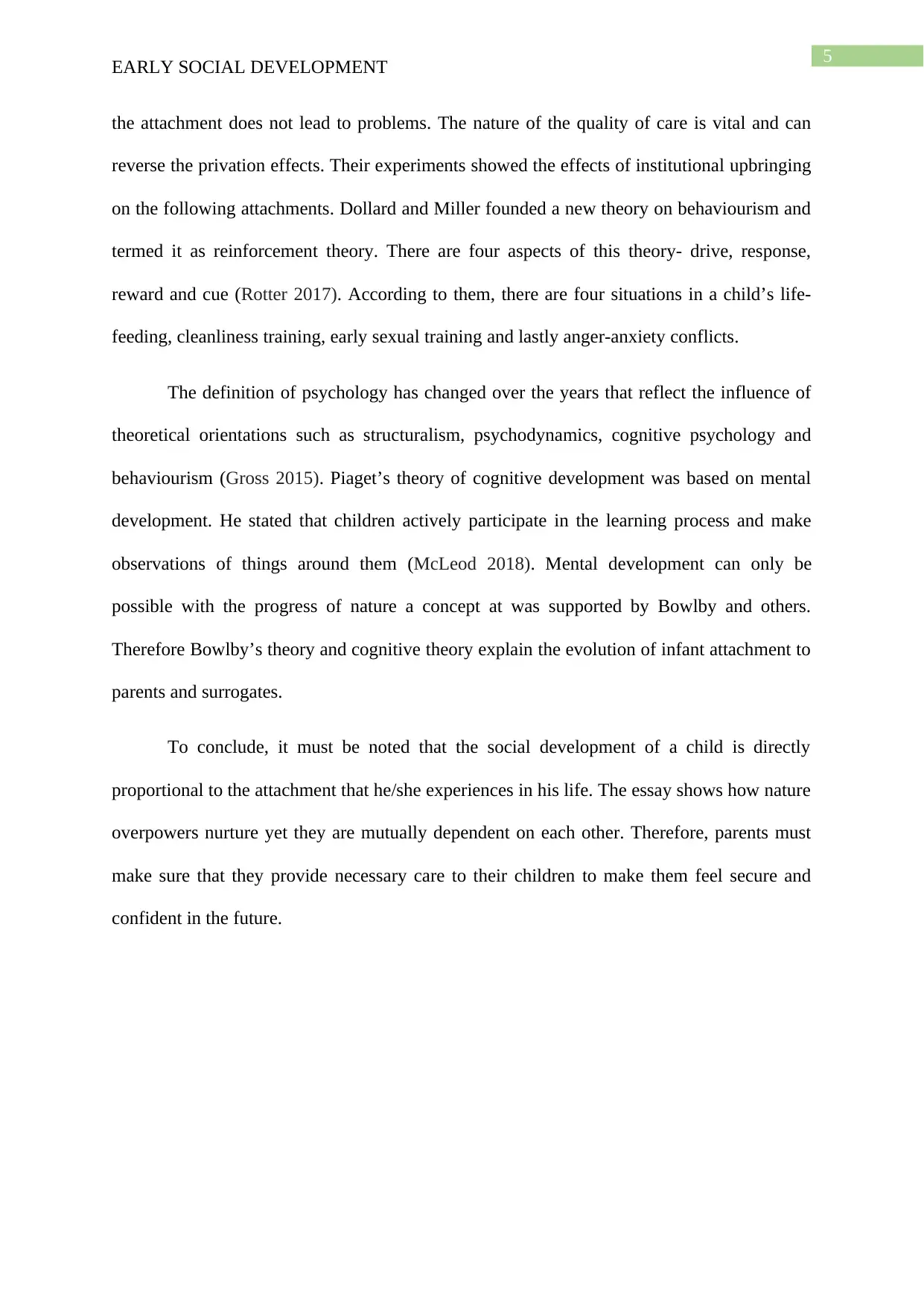
5
EARLY SOCIAL DEVELOPMENT
the attachment does not lead to problems. The nature of the quality of care is vital and can
reverse the privation effects. Their experiments showed the effects of institutional upbringing
on the following attachments. Dollard and Miller founded a new theory on behaviourism and
termed it as reinforcement theory. There are four aspects of this theory- drive, response,
reward and cue (Rotter 2017). According to them, there are four situations in a child’s life-
feeding, cleanliness training, early sexual training and lastly anger-anxiety conflicts.
The definition of psychology has changed over the years that reflect the influence of
theoretical orientations such as structuralism, psychodynamics, cognitive psychology and
behaviourism (Gross 2015). Piaget’s theory of cognitive development was based on mental
development. He stated that children actively participate in the learning process and make
observations of things around them (McLeod 2018). Mental development can only be
possible with the progress of nature a concept at was supported by Bowlby and others.
Therefore Bowlby’s theory and cognitive theory explain the evolution of infant attachment to
parents and surrogates.
To conclude, it must be noted that the social development of a child is directly
proportional to the attachment that he/she experiences in his life. The essay shows how nature
overpowers nurture yet they are mutually dependent on each other. Therefore, parents must
make sure that they provide necessary care to their children to make them feel secure and
confident in the future.
EARLY SOCIAL DEVELOPMENT
the attachment does not lead to problems. The nature of the quality of care is vital and can
reverse the privation effects. Their experiments showed the effects of institutional upbringing
on the following attachments. Dollard and Miller founded a new theory on behaviourism and
termed it as reinforcement theory. There are four aspects of this theory- drive, response,
reward and cue (Rotter 2017). According to them, there are four situations in a child’s life-
feeding, cleanliness training, early sexual training and lastly anger-anxiety conflicts.
The definition of psychology has changed over the years that reflect the influence of
theoretical orientations such as structuralism, psychodynamics, cognitive psychology and
behaviourism (Gross 2015). Piaget’s theory of cognitive development was based on mental
development. He stated that children actively participate in the learning process and make
observations of things around them (McLeod 2018). Mental development can only be
possible with the progress of nature a concept at was supported by Bowlby and others.
Therefore Bowlby’s theory and cognitive theory explain the evolution of infant attachment to
parents and surrogates.
To conclude, it must be noted that the social development of a child is directly
proportional to the attachment that he/she experiences in his life. The essay shows how nature
overpowers nurture yet they are mutually dependent on each other. Therefore, parents must
make sure that they provide necessary care to their children to make them feel secure and
confident in the future.
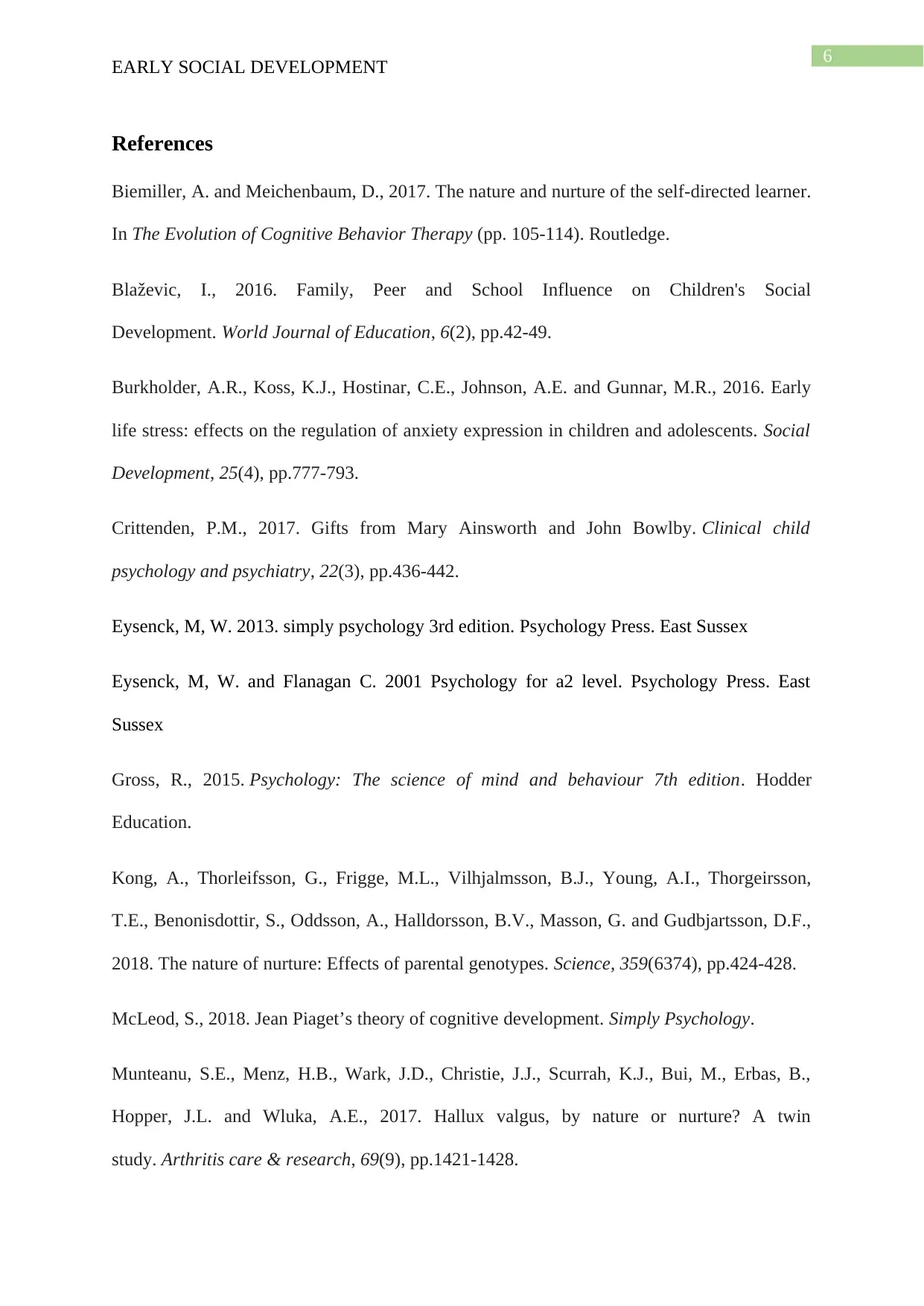
6
EARLY SOCIAL DEVELOPMENT
References
Biemiller, A. and Meichenbaum, D., 2017. The nature and nurture of the self-directed learner.
In The Evolution of Cognitive Behavior Therapy (pp. 105-114). Routledge.
Blaževic, I., 2016. Family, Peer and School Influence on Children's Social
Development. World Journal of Education, 6(2), pp.42-49.
Burkholder, A.R., Koss, K.J., Hostinar, C.E., Johnson, A.E. and Gunnar, M.R., 2016. Early
life stress: effects on the regulation of anxiety expression in children and adolescents. Social
Development, 25(4), pp.777-793.
Crittenden, P.M., 2017. Gifts from Mary Ainsworth and John Bowlby. Clinical child
psychology and psychiatry, 22(3), pp.436-442.
Eysenck, M, W. 2013. simply psychology 3rd edition. Psychology Press. East Sussex
Eysenck, M, W. and Flanagan C. 2001 Psychology for a2 level. Psychology Press. East
Sussex
Gross, R., 2015. Psychology: The science of mind and behaviour 7th edition. Hodder
Education.
Kong, A., Thorleifsson, G., Frigge, M.L., Vilhjalmsson, B.J., Young, A.I., Thorgeirsson,
T.E., Benonisdottir, S., Oddsson, A., Halldorsson, B.V., Masson, G. and Gudbjartsson, D.F.,
2018. The nature of nurture: Effects of parental genotypes. Science, 359(6374), pp.424-428.
McLeod, S., 2018. Jean Piaget’s theory of cognitive development. Simply Psychology.
Munteanu, S.E., Menz, H.B., Wark, J.D., Christie, J.J., Scurrah, K.J., Bui, M., Erbas, B.,
Hopper, J.L. and Wluka, A.E., 2017. Hallux valgus, by nature or nurture? A twin
study. Arthritis care & research, 69(9), pp.1421-1428.
EARLY SOCIAL DEVELOPMENT
References
Biemiller, A. and Meichenbaum, D., 2017. The nature and nurture of the self-directed learner.
In The Evolution of Cognitive Behavior Therapy (pp. 105-114). Routledge.
Blaževic, I., 2016. Family, Peer and School Influence on Children's Social
Development. World Journal of Education, 6(2), pp.42-49.
Burkholder, A.R., Koss, K.J., Hostinar, C.E., Johnson, A.E. and Gunnar, M.R., 2016. Early
life stress: effects on the regulation of anxiety expression in children and adolescents. Social
Development, 25(4), pp.777-793.
Crittenden, P.M., 2017. Gifts from Mary Ainsworth and John Bowlby. Clinical child
psychology and psychiatry, 22(3), pp.436-442.
Eysenck, M, W. 2013. simply psychology 3rd edition. Psychology Press. East Sussex
Eysenck, M, W. and Flanagan C. 2001 Psychology for a2 level. Psychology Press. East
Sussex
Gross, R., 2015. Psychology: The science of mind and behaviour 7th edition. Hodder
Education.
Kong, A., Thorleifsson, G., Frigge, M.L., Vilhjalmsson, B.J., Young, A.I., Thorgeirsson,
T.E., Benonisdottir, S., Oddsson, A., Halldorsson, B.V., Masson, G. and Gudbjartsson, D.F.,
2018. The nature of nurture: Effects of parental genotypes. Science, 359(6374), pp.424-428.
McLeod, S., 2018. Jean Piaget’s theory of cognitive development. Simply Psychology.
Munteanu, S.E., Menz, H.B., Wark, J.D., Christie, J.J., Scurrah, K.J., Bui, M., Erbas, B.,
Hopper, J.L. and Wluka, A.E., 2017. Hallux valgus, by nature or nurture? A twin
study. Arthritis care & research, 69(9), pp.1421-1428.
Paraphrase This Document
Need a fresh take? Get an instant paraphrase of this document with our AI Paraphraser
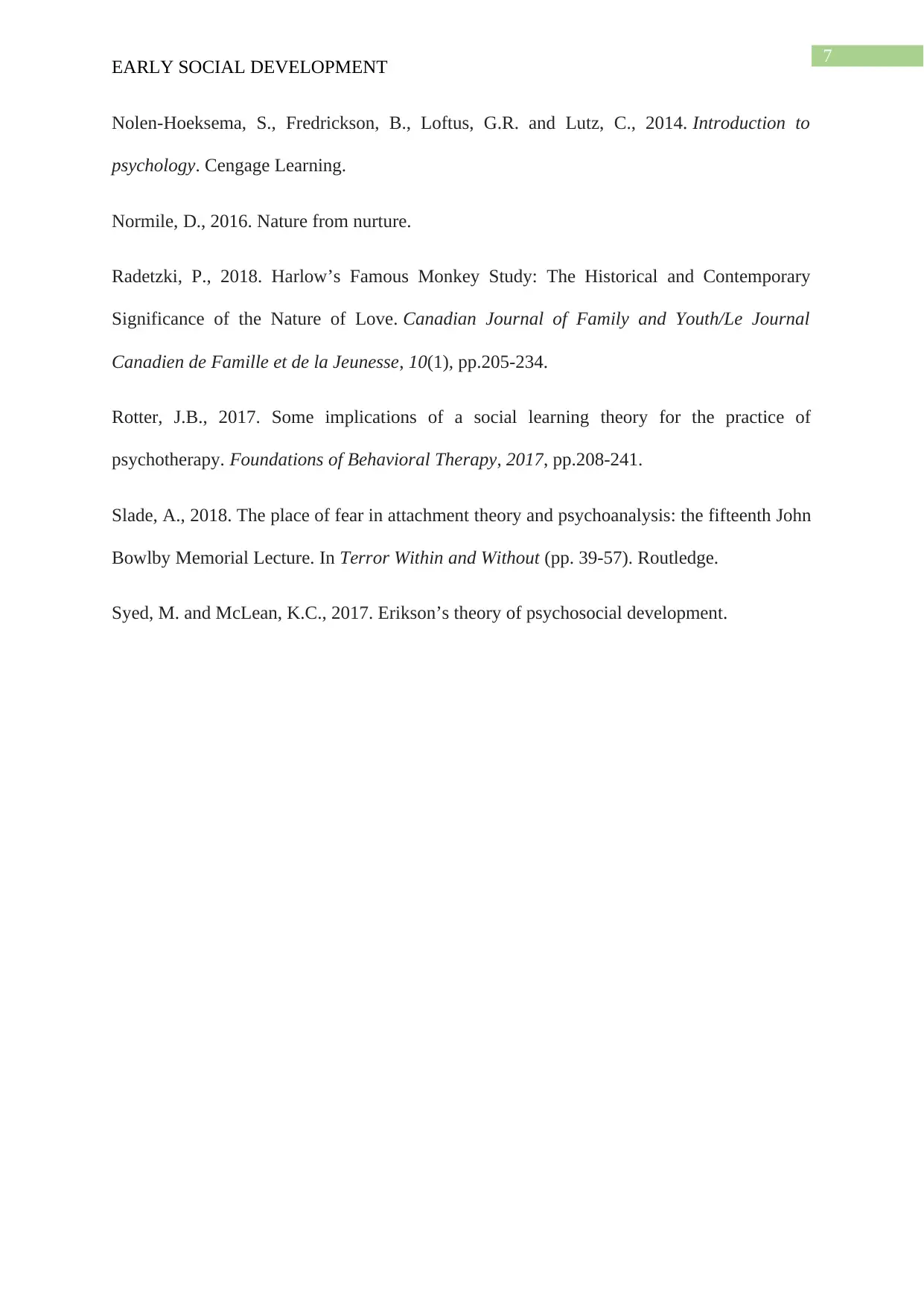
7
EARLY SOCIAL DEVELOPMENT
Nolen-Hoeksema, S., Fredrickson, B., Loftus, G.R. and Lutz, C., 2014. Introduction to
psychology. Cengage Learning.
Normile, D., 2016. Nature from nurture.
Radetzki, P., 2018. Harlow’s Famous Monkey Study: The Historical and Contemporary
Significance of the Nature of Love. Canadian Journal of Family and Youth/Le Journal
Canadien de Famille et de la Jeunesse, 10(1), pp.205-234.
Rotter, J.B., 2017. Some implications of a social learning theory for the practice of
psychotherapy. Foundations of Behavioral Therapy, 2017, pp.208-241.
Slade, A., 2018. The place of fear in attachment theory and psychoanalysis: the fifteenth John
Bowlby Memorial Lecture. In Terror Within and Without (pp. 39-57). Routledge.
Syed, M. and McLean, K.C., 2017. Erikson’s theory of psychosocial development.
EARLY SOCIAL DEVELOPMENT
Nolen-Hoeksema, S., Fredrickson, B., Loftus, G.R. and Lutz, C., 2014. Introduction to
psychology. Cengage Learning.
Normile, D., 2016. Nature from nurture.
Radetzki, P., 2018. Harlow’s Famous Monkey Study: The Historical and Contemporary
Significance of the Nature of Love. Canadian Journal of Family and Youth/Le Journal
Canadien de Famille et de la Jeunesse, 10(1), pp.205-234.
Rotter, J.B., 2017. Some implications of a social learning theory for the practice of
psychotherapy. Foundations of Behavioral Therapy, 2017, pp.208-241.
Slade, A., 2018. The place of fear in attachment theory and psychoanalysis: the fifteenth John
Bowlby Memorial Lecture. In Terror Within and Without (pp. 39-57). Routledge.
Syed, M. and McLean, K.C., 2017. Erikson’s theory of psychosocial development.
1 out of 8
Related Documents
Your All-in-One AI-Powered Toolkit for Academic Success.
+13062052269
info@desklib.com
Available 24*7 on WhatsApp / Email
![[object Object]](/_next/static/media/star-bottom.7253800d.svg)
Unlock your academic potential
© 2024 | Zucol Services PVT LTD | All rights reserved.





